by W. Cranshaw* (1/17)
Quick Facts…
- Indian meal moth is a small, grayish-brown moth common in many Colorado homes. The caterpillar stage feeds on nuts, herbs, coarsely ground grains, and other pantry items.
- The first stage of control is to identify all potential sources of infestation in a home.
- Infested materials should be discarded, promptly used up, or treated with heat or cold to kill insects found in the food. A thorough clean-out of all food sources is critical to managing Indian meal moth.
- Storing items in insect resistant containers or in cold storage can prevent reinfestation.
The Indian meal moth (Plodia interpunctella) is the most common household moth that can reproduce in Colorado homes. It develops as a pest of various foods commonly found in pantries. The caterpillars can seriously damage susceptible food items and the adult moths can become annoying as they fly through the home.
Description
All stages of the Indian meal moth may be found in homes. The adult is a small moth, about 3/8 inch long with a wing span of about 5/8 inch. The overall body color is generally dirty gray but the tip half of the wing is rusty brown or nearly bronze. This wing marking pattern allows Indian meal moth to be easily distinguished from other household moths.
The caterpillar stage is usually cream colored, sometimes with yellowish-green or pinkish shades, and has a dark brown head. Normally they stay associated with foods, but the full grown caterpillars, about 2/3 inch long, may be seen as they wander in search of a place to pupate.
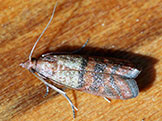 |
Figure 1. Adult Indian meal moth. (Photo from the K. Gray collection.) |
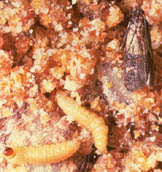 |
Figure 2: Indian meal moths cause problems on dried food products in the home. Adult and larvae shown. |
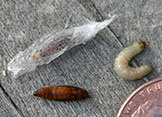 |
Figure 3. Full-grown larva and pupa of Indian meal moth. (Photo by W. Cranshaw.) |
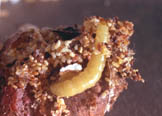 |
Figure 4. Indian meal moth larva.
|
Life History and Habits
Indian meal moths develop in many kinds of stored foods. Coarsely ground grains and cereal products are commonly infested. Dried herbs, dried fruits, and nuts are also highly favored. Pet foods such as dried dog food, flaked fish food, and bird seed can also become infested. Indian meal moth may also breed in ornamental items made of dried flowers or seeds.
The moths usually fly at dusk and through the night. Females lay tiny eggs (ca. 0.5 mm) on or near potential food items. The newly hatched caterpillars (larvae) seek out foods and begin to develop. As they feed they often produce silk that loosely binds to food fragments. In large, undisturbed
containers feeding is concentrated on the surface as the larvae do little burrowing. However, caterpillars may occur throughout the product within small, loose packages typically found in household pantries. The caterpillars are capable of chewing through plastic bags and thin cardboard.
The rate of development is dependent on factors including temperature and food quality. Under optimum temperatures the caterpillars may become fully-grown in as little as a month; development typically requires a much longer period. When feeding is completed the caterpillars usually wander from the food and search for a place to pupate. They then create a loose cocoon covering within which they pupate and subsequently transform to the adult stage. Coccoons are most often located in cracks or confined spaces, such as the junction between walls and ceiling.
The adults emerge, mate and lay eggs. Since the moths do not feed they usually survive little more than a week. During this time the female may deposit over 200 eggs, laid either directly on food or in crevices adjacent to the stored foods on which they feed.
Probably three or four generations can be completed annually in a Colorado home although all stages may be present as generations overlap. For reasons that are unclear, adults are usually observed most commonly from November through February.
Control of Indian Meal Moth
The first, and most critical, step is to identify all sources of infestation. The presence of some webbing is usually the most effective way to determine which items are infested.
This examination must be thorough as the range of materials potentially infested is so broad. First go through items in the pantry which may host Indian meal moth. They are commonly found in coarse cereal products (e.g, oatmeal, breakfast cereals), nuts, herbs and spices, dried soups, dried fruits and vegetables. Pay particular attention to items that have remained in the cupboard for long periods. Foods that are loosely sealed or are in thin wrapping are more likely to be infested than materials in insect resistant containers such as hard plastic or metal.
Indian meal moth may also be found in other materials around the home. Dried dog food and bird seed should be checked. Dried flowers and some craft items that include seeds may be infested. Areas where flour and other materials used in baking may have spilled can support Indian meal moth. Larvae are also known to occur in the stored caches of seeds and nuts that squirrels and other rodents may have around the home.
Infested material should be immediately discarded, used up, or somehow treated to disinfest. Treatments involve using heat or cold to kill any larvae and eggs that may be in the food. Cold treatment requires putting infested items in deep freeze for at least two or three days. Effectiveness of cold treatment may be improved by alternating freezing treatments with
rewarming to room temperatures for a few days. High temperature treatments involve oven heating at around 120 to 140 degrees F for 20 minutes. (Somewhat longer intervals are needed if treated items are bulky, requiring longer periods to raise internal temperatures.) Injury to the food is possible with excessively high temperature treatments.
Since insects also can develop on spilled food, thoroughly clean areas where food was stored by vacuuming or sweeping upall spilled food. The thoroughness of the cleaning is important primarily to eliminate food for surviving insects to feed on. The nature of the cleaning agent (soapy water, bleach, etc.) is less important than the permanent elimination of the food.
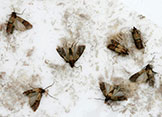 |
Figure 5. Indian meal moths captured at pheromone trap. (Photo by W. Cranshaw.) |
Heat or cold treated objects are capable of being immediately reinfested as long as Indian meal moths remain in the home so extra care should be taken during this stage. Although adult moths may only live for a week or so, larvae that have recently pupated in hidden areas of the home may
also be a potential source of reinfestation. Therefore Indian meal moths must be denied access to all food sources for the length of time that is required to complete the pupal stage plus how long the adult life span can be. A month should be adequate to cover this period.
In the interim, susceptible food items must be stored to prevent reinfestation. Place foods in tightly sealed containers. Food also may be stored in the refrigerator or outdoors until the moths have died out.
Although Indian meal moth can be eliminated, reinfestation are always possible through accidental reintroductions on infested food. Consideration should be given to how bulk foods are stored. Bulk seeds and other commonly infested foods (e.g., bird seed, dog food) should be stored in outbuildings away from the pantry area. Foods in pantries should be stored in containers that are tight-fitting enough to prevent entry by the minute early stage larvae and must be thick enough to prevent it being penetrated by the chewing of late stage larvae.
Use of insecticides within the pantry area is not recommended and will normally give little, if any, additional control in the absence of a thorough clean up and treament of infested materials. Some household insecticide may allow crack and crevice treatments near food storage areas, but these
must be restricted to these site. Never apply insecticides in a manner that allows direct contact with food, food preparation surfaces or food utensils.
There are available traps for Indian meal moth that are baited with an attractant known as a sex pheromone. This is the chemical used by the female Indian meal moth to attract males. Such traps are very useful for identify “hot spots” of infestation. However their ability to control Indian meal moth is highly doubtful, despite occasional claims to this effect by suppliers. This is because the traps only capture males, and usually only a fraction of these. As mated females are not captured,
they will continue reinfestation.
*Colorado State University Extension entomologist and professor, bioagricultural sciences and pest management. 4/03. Revised 1/17.
Colorado State University, U.S. Department of Agriculture, and Colorado counties cooperating. CSU Extension programs are available to all without discrimination. No endorsement of products mentioned is intended nor is criticism implied of products not mentioned.
Go to top of this page.





